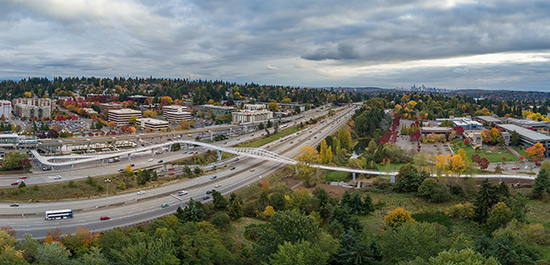|
Subscribe / Renew |
|
|
Contact Us |
|
| ► Subscribe to our Free Weekly Newsletter | |
| home | Welcome, sign in or click here to subscribe. | login |
Construction
| |
 |
March 28, 2022
Best in State: Gold Award
Social, economic and sustainable design

David Evans and Associates
Project: John Lewis Memorial Bridge
Client: City of Seattle DOT
The construction of I-5 in the 1960s through North Seattle divided the Northgate neighborhood, separating residents and North Seattle College on the west side of the freeway from shopping districts, business parks, and currently major transit stations for bus, light rail, and parking east of I-5. For those traveling locally by foot, travel times of 22 minutes to cross I-5 were not uncommon. The two existing crossings are approximately one mile apart, neither of which directly connect to significant points of interest.
The John Lewis Memorial Bridge connects 1,500 projected daily users across I-5. Overall, the bridge creates a third centralized crossing that reduces local travel time to 10 minutes on average to cross I-5. This new pedestrian and bicycle connection improves access to transit, North Seattle College, the University of Washington satellite medical facility and neighborhoods to the west of I-5 with transit, the Northgate urban growth center and neighborhoods east of I-5.
The David Evans and Associates team used a value-engineering approach to designing the new span within budget constraints while meeting the design and pragmatic goals set by the community. These priorities included safe and easy access for bicycles and pedestrians, mitigating environmental and ecological issues, managing drainage and stormwater, and addressing site constraints to minimize disruption to traffic on I-5 during construction. Input from extensive public outreach helped inform the design while addressing these challenges. Designing an aesthetically pleasing landmark structure was essential for the Seattle Department of Transportation due to the high visibility for those traveling on I-5 and the surrounding communities.
Through collaboration with the architect, the David Evans and Associates design team utilized a visually pleasing Vierendeel truss to serve as an iconic landmark for this North Seattle neighborhood. The design seamlessly blends four different span types with a family of V-shaped columns to create visual continuity without negatively impacting the local environment while providing visual rhythm along the bridge. The bridge alignment creates clear sightlines for safety, and a highly transparent cable netting barrier enhances visibility and protection for those crossing the bridge.
The main span over I-5 was divided into two spans to reduce the construction cost and address constructability challenges. A 234-foot-long Vierendeel steel truss and a 135-foot-long steel through-girder span over an on-ramp, the southbound, northbound, and express lanes of I-5 with a single column pier founded on a drilled shaft placed between the express lane ramp and the northbound lane where space allowed. These truss and through girders were crucial for minimizing traffic disruption on the busy freeway because assembly used the accelerated bridge construction method. This method allowed the superstructure to be assembled off-site, transported to the site using a self-propelled modular transporter, and erected overnight, limiting the closure of I-5 to just two nights.
The city of Seattle Department of Transportation led the project as the prime consultant, supported by a team composed entirely of small disadvantaged business enterprises operating as subconsultants to deliver this complex bridge project. Working with the small/DBE firms generated revenue for the local economy, expanded the capabilities and capacity of the small/DBE firms, and created relationships with SDOT for possible future work.
Sustainable design was a high priority for the Department of Transportation, the public, and the project team. The project site is in the upper reaches of Thornton Creek, in an urban watershed that drains into Lake Washington. Plantings restored the project site and enhanced the ecological value of the project area. With a broad range of environmental and cultural conditions on-site, the selected plant communities meet the specific needs of each location. Wetlands were enlarged and restored, and trees were replaced at a ratio of nearly 5:1.
Other Stories:
- National Finalist: Platinum award
Special Projects - National Finalist: Gold Award
Special Projects - National Finalist: Gold Award
Water Resources - National Finalist: Gold Award
Transportation - Best in State: Gold Award
Social, economic and sustainable design - Best in State: Gold Award
Complexity - Diversity and Inclusion Award: Mid-Size Firms
- Diversity and Inclusion Award: Large Firm
- Engineer of the Year
- Best in State: Gold Award
Successful fulfillment of client/owner needs - Best in State: Gold Award
Future value to the engineering profession - Best in State: Gold Award
Future value to the engineering profession - Best in State: Gold Award
Unique or innovative application of new or existing techniques - Diversity and Inclusion Award: Mid-Size Firms
- National Finalist: Gold Award
Structural Systems


